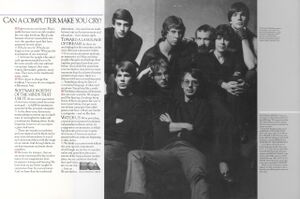
|
This page contains a transcription of the full text of the original print advertisement for Electronic Arts[1]. I think it's an absolutely beautiful ad—it's quite inspirational to me—and its copy exactly describes the game industry I hope we eventually create.
|
Right now, no one knows. This is partly because many would consider the very idea frivolous. But it's also because whoever successfully answers this question must first have answered several others.
Why do we cry? Why do we laugh, or love, or smile? What are the touchstones of our emotions?
Until now, the people who asked such questions tended not to be the same people who ran software companies. Instead, they were writers, filmmakers, painters, musicians. They were, in the traditional sense, artists.
We're about to change that tradition. The name of our company is Electronic Arts.
Software worthy of the minds that use it.
We are a new association of electronic artists united by a common goal—to fulfill the enormous potential of the personal computer.
In the short term, this means transcending its present use as a facilitator of unimaginative tasks and a medium for blasting aliens. In the long term, however, we can expect a great deal more.
These are wondrous machines we have created, and in them can be seen a bit of their makers. It is as if we had invested them with the image of our minds. And through them, we are learning more and more about ourselves.
We learn, for instance, that we are more entertained by the involvement of our imaginations than by passive viewing and listening. We learn that we are better taught by experiences than by memorization. And we learn that the traditional distinctions—the ones that are made between art and entertainment and education—don't always apply.
Towards a language of dreams.
In short, we are finding that the computer can be more than just a processor of data.
It is a communications medium: an interactive tool that can bring people's thoughts and feelings closer together, perhaps closer than ever before. And while fifty years from now, its creation may seem no more important than the advent of motion pictures or television, there is a chance it will mean something more.[2]
Something along the lines of a universal language of ideas and emotions. Something like a smile.
The first publications of Electronic Arts are now available.[3] We suspect you'll be hearing a lot about them. Some of them are games like you've never seen before, that get more out of your computer than other games ever have. Others are harder to categorize—and we like that.
Watch us.
We're providing a special environment for talented, independent software artists. It's a supportive environment, in which big ideas are given room to grow. And some of America's most respected software artists are beginning to take notice.
We think our current work reflects this very special commitment. And though we are few in number today and apart from the mainstream of the mass software marketplace, we are confident that both time and vision are on our side.
Join us. We see farther.
Software artists?
"I'm not so sure there are any software artists yet," says Bill Budge. "We've got to earn that title." Pictured here are a few people who have come as close to earning it as anyone we know.
That's Mr. Budge himself, creator of Pinball Construction Set, at the upper right. To his left are Anne Westfall and Jon Freeman who, along with their colleagues at Free Fall Associates, created Archon and Murder on the Zinderneuf.
Left of them is Dan Bunten of Ozark Softscape, the firm that wrote M.U.L.E. To Dan's left are Mike Abbot (top) and Matt Alexander (bottom), authors of Hard Hat Mack. In the center is John Field, creator of Axis Assassin and The Last Gladiator. David Maynard, lower right, is the man responsible for Worms?
When you see what they've accomplished, we think you'll agree with us that they can call themselves whatever they want.



